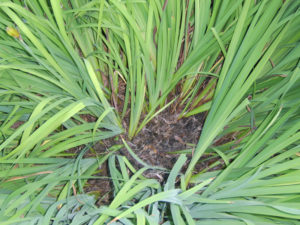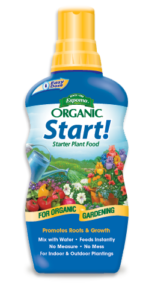Espoma helps divided plants thrive!
Spring is a great time to divide many summer and fall-blooming perennials that have grown too big for their britches and are crowding neighboring plants. Dividing plants is good for them, despite how stressful it may look or feel to you. Division stimulates new root growth. Younger roots are more efficient at their job than older ones. Plus dividing perennials yields more plants (especially valuable for perennials that don’t come true from seed), opens up space between plants, reduces disease and insect problems, and allows more nutrients per plant from less root competition. (pictured below – Siberian Iris crying out to be divided!)
Recommended steps for dividing perennials (excerpt from my book The Ultimate Flower Gardener’s Top Ten Lists)
*water the garden the day before so the soil is easier to work
*if there is a lot of foliage, cut back some for easier handling and to be able to see the roots better
*insert the spade straight down and dig a circle around the plant at a distance of four to six inches from the outer stems
*lift the plant from soil, shake some soil from the roots and place the clump on its side. If the perennial is too big to lift in one clump, create ‘subdivisions’ by carving sections right in the ground with a spade or knife and then give these the old heave ho
*work soil away from roots with your fingers or use a strong spray of water to blast soil free so you can see the roots
*divide by either 1) slicing with a spade or knife, 2) pulling sections apart with your hands or 3) breaking off newer outer growth. The double fork method is frequently mentioned but you need two people to do this and the process is overrated
*discard any old woody sections
*if you are replanting a division where the original plant was, you will need to add additional soil to make up for the loss of mass. While you are at it, add a dollop of organic matter like compost or aged manure
*set the division in the hole, pour in about a cup of diluted liquid fertilizer – Espoma’s Organic Start!
* Back fill with soil and water in with ‘plain’ water. Make sure the plant’s crown, where the stems meet the roots, is level with the soil. Not too deep, not too high, but just right.
*Espoma’s Organic Start! is one of three new liquid organic fertilizers available from Espoma, an industry leader in organic fertilizers. Start! is a plant’s version of our high-energy juice drinks – quickly available to the plant for healthy results. Espoma’s unique Easy Dose Cap pours the perfect amount without any measuring or mess! Organic Start! (1-2-2) helps plants bounce back quickly after being divided and also promotes rapid root growth. This in turn generates a flush of new foliage growth which will be followed by oodles of flowers.


